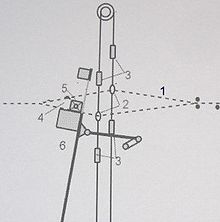Subject (weaving)
The compartment referred to in the weaving of the diamond-shaped gap or cavity between the upper and lowered warp yarns occurs and the entry of the weft thread is used.
The shed is a dynamic structure that is closed during the weaving process after each weft insertion, and in another form - depends on the used binding is reopened -. The length of the compartment is limited at the front by the fabric. The center of the subject is in the area of the shafts . With the free-standing loom ( basse lisse ) the shed is horizontal, with the weight loom the shed is vertical.
Around the shuttle to lead or shuttles possible unobstructed and without flaw through the shed, it should be opened wide and as clean as possible. One speaks of a clean shed when all the warp threads on different shafts are at the same height when viewed from the side. For this purpose, the middle shafts must be dug out more strongly than the front and rear in multi-weave bindings or fabrics, the lacing of the steps must be adjusted accordingly. On the other hand, the compartment must not be opened too wide, because otherwise a high tension would arise in the threads and the mechanical effort would be unnecessarily great.
The height of the shed is influenced or limited by:
- the length of the loom
- the length of the strands and the strand eyes
- the so-called jump height of the weaver blade (web comb)
- the type of shaft excavation (roller pull or counter march)
literature
- Erika Arndt: Weaving manual. History, materials and techniques of hand weaving . Bern 2006, ISBN 3-258-06993-X
- Allen Fannin: Handloom weaving technology . New York 1998 ISBN 1-55821-612-X (English language)

